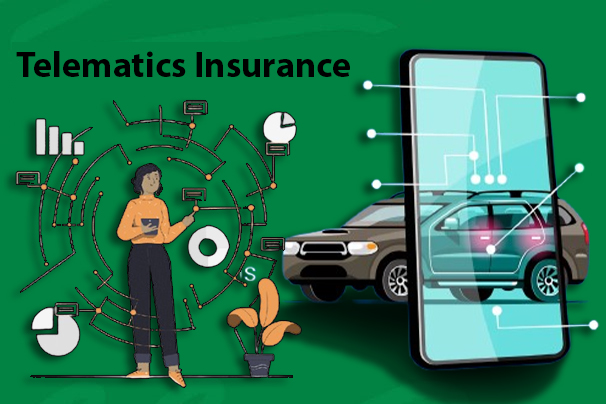Telematics Insurance – A lot of the best car insurance companies provide telematics programs, but no two are exactly alike. In this article, you will learn the different kinds of telematics and usage-based insurance options available today. Telematics insurance makes use of monitoring technology to adjust or set auto insurance rates.

It is also known as usage-based insurance (UBI). It is in two forms. Mileage-based insurance sets rates built in part on how much you drive. Behavior-based insurance provides discounts built on safe driving. Insurance companies track your driving with a mobile app or a plug-in device. The data generated assists in setting your car insurance rate.
What Is Telematics Insurance?
Telematics insurance is also known as pay-as-you-drive insurance, usage-based insurance, or pay-per-mile insurance. It is the process of allowing your insurance company to tailor your rates to your exact risk level. It can assist in reducing the cost of your car insurance built on your driving habits. If you are a young driver or you just started driving, this type of policy can be beneficial to manage your costs until you gain more experience on the road.
How Does Telematics Insurance Work?
Telematics car insurance programs gather data to rate your driving safety and/or track your distance. The programs gather data connected to when you drive, how you drive, and where you drive to calculate your risk level. If you pose a lower risk of an accident than the average driver, that means you can save money on your auto insurance premiums.
Vehicle Telematics
It does not matter the type of telematics program; insurers track policyholders’ driving behavior in real time. In some cases, you can choose the telematics technology that you would like to make use of. Note that different devices can track different things. For instance, a smartphone app can track your phone use while driving, but a plug-in device can’t.
Telematics Devices
Some common devices used in the telematics systems of auto insurance companies that are making use of them to gather usage statistics and monitor driving habits are as follows:
- Diagnostic port plug-in devices.
- Bluetooth beacons.
- Mobile apps.
It all depends on the provider; you might be able to spread driving data through a built-in option like OnStar.
The Business Benefits of Telematics Insurance
Telematics insurance has a lot of business benefits, and they are as follows:
Accurate pricing
With telematics insurance data, insurance carriers can price premiums and policies more precisely, so they truly replicate the risk of insuring their customers. Accurate pricing is the groundwork for lucrative business operations and keeps rates stable. Telematics insurance can assist in avoiding the significant rate swings that result in customer erosion.
Risk reduction
Insurance telematics makes it easier for providers to gather large amounts of data and to develop more sophisticated risk models to limit their overall risk exposure. If insurers do take on higher risk, they can be self-assured that the premiums cover their exposure.
New product development
Usage-based insurance programs can offer discounts for customers by gratifying them for good driving behavior. Telematics insurance supports new pay-as-you-drive (PAYD) programs, which are becoming more and more well-known among customers.
Accurate pricing
With telematics insurance data, insurance carriers can price premiums and policies more precisely, so they truly replicate the risk of insuring their customers. Accurate pricing is the groundwork for lucrative business operations and keeps rates stable. Telematics insurance can assist in avoiding the significant rate swings that result in customer erosion.
Better, faster decision-making
By integrating insurance telematics data into actuarial and underwriting, core system, policy administration, billing, and claims, and also as a new action-oriented policyholder portal. More predictive and faster choices can be made, even in real time.
Increased efficiency
With telematics insurance, manual and time-intensive work can be made efficient or removed as processes are automated with precise geospatial and vehicle data.
Telematics Insurance Discount
If you sign up for a telematics program, you will always receive an enrollment discount, which may be about 5% to 10%. You will either download an app or get a telematics device in the mail. Throughout the first policy period, the company will gather information on your driving habits.
When it is time for you to renew your policy, then you will see whether you will be eligible for a discount built on your driving habits and how steep your discount will be. Some programs need you to keep the tracking device installed at all times to keep a discount. Others track your driving habits for one policy period and put on the discount for all future periods. You need to do some things to get the best discount. They are as follows:
- Avoid cornering and harsh braking.
- Have below-average distance.
- Dodge quick acceleration.
- Avoid nighttime and rush-hour driving.
Drivers who see the best discounts may be retirees and gentle drivers, stay-at-home parents, and remote workers.
Final Thought
In conclusion, some policies will reward you with low-priced insurance when you come to renew if you accumulate a good enough score. Other policies will provide you insurance that is lower than a standard policy from the start but will provide you with a worse deal when you renew if you drive poorly. These policies have a tendency to be well known with those who otherwise face high costs for their insurance, such as young, new, or convicted drivers.



